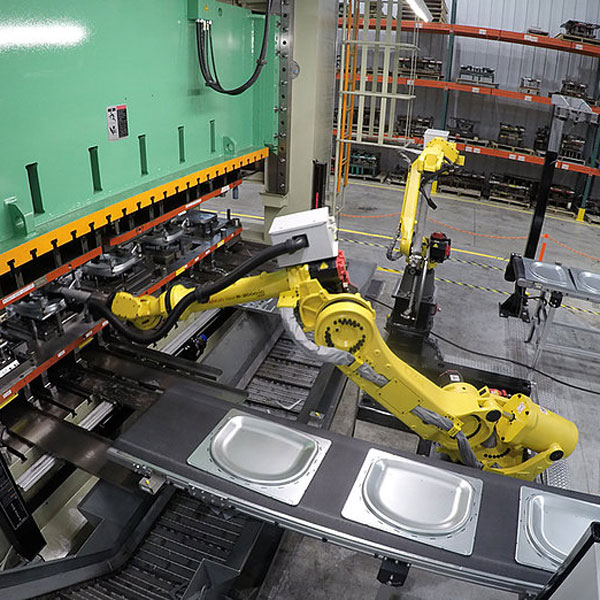Advanced Metal Stamping Techniques for Accuracy Manufacturing
Advanced Metal Stamping Techniques for Accuracy Manufacturing
Blog Article
Metal Stamping Technologies: Elevating Production Processes for Superior Results
In the realm of making processes, steel stamping has actually long been a foundation method for producing an array of precision elements. With the ruthless march of technical improvement, the landscape of metal marking is undertaking a substantial improvement.
Development of Steel Marking Strategies

Furthermore, innovations in product science have actually caused the advancement of high-strength alloys that can currently be effortlessly marked into elaborate shapes, accommodating a wider variety of industrial applications. The combination of robotics and expert system has actually even more enhanced the marking procedure by improving rate and accuracy while lowering the danger of human mistake.

Impact of Advanced Products
Have innovative materials changed metal stamping processes considerably in the production market? By making use of products such as high-strength alloys, advanced compounds, and innovative finishes, steel stamping procedures can currently produce components that are lighter, more powerful, and a lot more long lasting than ever previously.
These advanced products provide remarkable mechanical residential properties, rust resistance, and thermal security, permitting suppliers to fulfill the needs of contemporary sectors such as aerospace, automotive, and electronics. In addition, making use of sophisticated materials in metal marking has helped with the manufacturing of complex geometries and detailed styles that were formerly unattainable with conventional techniques.
In addition, the application of sophisticated materials has actually brought about reduced product waste, lower production expenses, and much shorter lead times, making metal marking processes a lot more sustainable and economical. As modern technology remains to advance, the influence of innovative materials on steel marking procedures is anticipated to drive further advancement and boost the competition of manufacturers in the international market.
Automation in Steel Stamping
The evolution of steel stamping processes driven by the integration of innovative materials has established the phase for considerable developments in automation within the production sector. Automation in metal marking has actually transformed manufacturing procedures, enhancing performance, precision, and total output high quality. With the utilization of robotics, sensors, and computer-controlled systems, jobs that were lengthy and once manual can now be implemented with exceptional rate and precision.
Automation in metal stamping not just speeds up production prices however also guarantees consistency in the production procedure. By minimizing human intervention, the threat of mistakes is considerably reduced, go leading to greater levels of product uniformity and dependability. Additionally, automation allows suppliers to carry out complicated stamping jobs that would certainly be impractical or tough to attain manually.
Moreover, automation in metal marking adds to a safer working setting by minimizing the requirement for workers to involve in unsafe or repeated jobs - Metal Stamping. This shift towards automation not just improves efficiency however also leads the means for the future of production, where modern technology plays a main duty in driving functional quality
Quality Assurance and Evaluation Systems
With a focus on precision and reliability, quality control and inspection systems play a critical role in making certain product excellence in steel stamping processes. These systems are developed to keep track of every phase of production, from product assessment to the final product, to more helpful hints guarantee that all elements meet the needed criteria. By carrying out sophisticated technologies such as optical assessment systems, coordinate gauging equipments (CMM), and automated determining tools, makers can spot even the tiniest inconsistencies in measurements, surface quality, and total honesty of stamped components.

Sustainability Practices in Metal Stamping
Building upon the foundation of accuracy and reliability established with high quality control and inspection systems, the integration of lasting practices in metal stamping procedures is increasingly coming to be a prime focus for makers looking for to reduce environmental effect and enhance source utilization. Sustainability practices in steel stamping include a variety of campaigns intended at reducing waste generation, energy consumption, and greenhouse gas discharges throughout the manufacturing process.
One key element of sustainability in metal stamping is the fostering of eco-friendly products and innovations that promote recyclability and waste decrease. By utilizing recycled products and implementing energy-efficient machinery, manufacturers can reduce their carbon impact and add to an extra lasting production cycle. In addition, enhancing manufacturing processes to minimize product waste and power use not only profits the environment however additionally results in cost savings for services over time.
In addition, the implementation of lasting practices in steel marking can improve brand online reputation and interest environmentally mindful customers. As sustainability continues to get value in the production sector, integrating environmentally friendly campaigns right into metal marking processes is vital for long-lasting success and competitiveness in the market.
Verdict
To conclude, steel marking techniques have actually considerably progressed in time, incorporating advanced products and automation to improve producing processes. Quality control and assessment systems play an essential role in ensuring exceptional outcomes, while sustainability techniques are progressively being carried out to minimize ecological impact. These developments in click here to find out more steel marking have actually transformed the industry, resulting in a lot more effective and sustainable production techniques for different sectors.
Metal marking, once a manual and labor-intensive process, has transformed right into a highly automated and advanced technique of shaping metal sheets right into numerous forms and styles.Have innovative materials transformed metal marking procedures significantly in the manufacturing industry? By utilizing materials such as high-strength alloys, advanced compounds, and ingenious finishings, metal stamping processes can currently create components that are lighter, more powerful, and extra resilient than ever before.
The development of steel stamping processes driven by the integration of sophisticated materials has established the stage for significant developments in automation within the manufacturing industry.In verdict, steel stamping techniques have significantly progressed over time, including innovative products and automation to improve producing processes.
Report this page